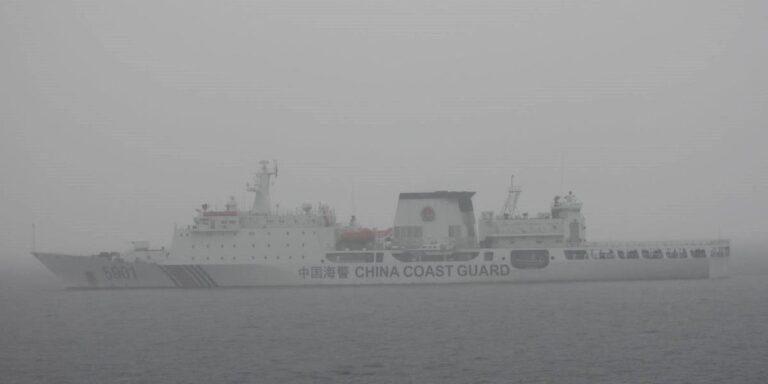- China’s largest coast guard ship was anchored in Manila’s exclusive economic zone earlier this week.
- The Philippine Coast Guard said the ship was anchored there due to “threats.”
- Maritime relations between China and the Philippines have become increasingly tense in recent months.
The Philippine Coast Guard (PCG) announced earlier this week that the world’s largest coast guard vessel had anchored in Manila’s Exclusive Economic Zone (EEZ) in the South China Sea.
PCG spokesperson Jay Tarriera wrote on X that the agency had successfully used “Canadian Dark Vessel Detection technology” to track the movements of a “165-metre monster vessel” belonging to the China Coast Guard (CCG).
“The vessel left Hainan Island on July 1 and entered the Philippine Exclusive Economic Zone (EEZ) the following day,” he wrote.
The 12,000-tonne CCG5901 was subsequently “radio-intercepted” by the PCG, which asked it to confirm its intentions and reaffirm that it was operating within the EEZ, he added.
An exclusive economic zone is “an area of the ocean beyond a nation’s territorial waters, within which the coastal state has jurisdiction over both living and non-living resources.”
Tarriera wrote on Friday that the Chinese vessel had been anchored at Escoda Shoal “for more than two consecutive days” and “kept very close” to the PCG vessel. He added that the two vessels were “less than 800 yards” apart.
Tarriera later told a news forum that the Chinese ships’ movements were “an intimidation by the China Coast Guard.”
“We are not going to back down and we are not going to be intimidated,” he added.
China and Philippines maritime clashes on the rise
China and the Philippines have frequent clashes around Second Thomas Reef, an atoll within their exclusive economic zone.
China claims the reef and much of the South China Sea, but an international court of law ruled in 2016 that China’s claims to the waters within the “nine-dash line” had no legal basis.
In 1999, the Philippines ran the BRP Sierra Madre aground on a coral reef to assert its claim to the area.
But the reef, which the Brussels-based think tank International Crisis Group (ICG) calls a “dangerous flashpoint”, remains in place, with Chinese vessels constantly trying to thwart resupply efforts to the stranded ship.
Earlier this month, the China Coast Guard disrupted a resupply mission with “unsafe and deliberate water-spraying, ramming and obstruction actions,” according to a statement provided to U.S. Naval Institute News by a spokesperson for the Office of the Secretary of Defense.
Chinese and Philippine officials met on Tuesday and said they aimed to “rebuild trust” to help manage maritime disputes.
However, the Philippine Department of Foreign Affairs stressed that the country remains “committed to safeguarding its interests and upholding its sovereignty, sovereign rights and jurisdiction” in the South China Sea.
“Relatives between the two countries in the maritime domain have never been more precarious than they have been over the past seven months,” the ICG said in May.

